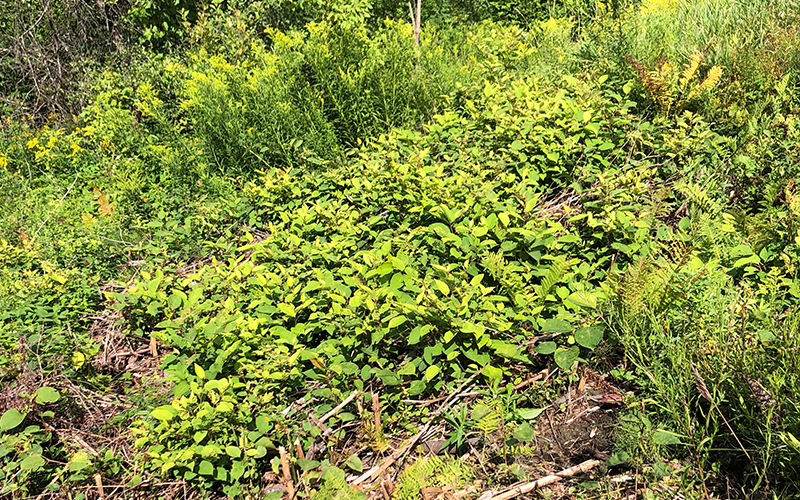Invasive Japanese knotweed is an issue throughout The Valley. Its 8-to-12-foot tall forests block access to the Mad River and many tributaries throughout The Valley and increasingly it is found on the sides of dirt and paved roads both at high and low elevations, not to mention on the edges of people’s yards and driveways.
Conservation commissions in Warren, Waitsfield and Fayston are all working on the issue through education, trial projects and boots on the ground. The Warren Conservation Commission is making visits to people’s houses to inspect their knotweed infestation and make recommendations on how to combat it.
“We want people to know that they can tackle it and control and eradicate it. It’s do-able,” said Warren Conservation Commission chair Jito Coleman, who showed up at my house with the commission’s intern, Avery Montgomery, on Monday, August 17.
Knotweed is spread uphill by heavy equipment and spread back downhill to the river by heavy rain events. My house is high up on a hill in Fayston and since it was built in 2006, there hasn’t been any heavy equipment use nor uphill flooding since I moved in. I was some what scared to find a patch of knotweed on the private road I share with two other families and another at the bottom of my lower yard a few years ago. I cut each section myself once and have had it weedwacked twice a year since then. Last year, after it had been weedwacked, I tried to burn the stalks but used gasoline rather than kerosene and failed.
Enter Jito and Avery (plus Tony Italiano with the Mad River Valley Television camera). August is just before the knotweed flowers they said and explained how its extensive route system allows it to reproduce so fast. For the patch by my road they suggested cutting it and letting the stalks dry completely before disposing of them as you would any dead plant. The Warren Conservation Commissioners have been researching what happens if you plant pieces of the stalks and the roots after varying numbers of days of drying out.
DRIED OUT AND DEAD
What they’ve learned is that – in a nutshell – knotweed behaves like any other plant. When its stalk is dried out and dead, it is dried out and dead. When the root pieces are dried out sufficiently they are dead. Dried up pieces of knotweed are not zombies that can come back to life with a sprinkle of rain. They are dead. But what does differentiate knotweed from other plants is the speed with which it can grow and replicate because of how the roots grow extensively and vigorously through the ground.
So, for the parcel on my road, the recommendation is to start trying to dig the roots out while continuing to keep the knotweed mowed. Each time the stalks are cut and chunks of the root are removed (and dried to death), you’re removing some of the energy from the plant’s bank account.
For the lower part of my yard, where the knotweed runs down a bank that is steep, they also recommend cutting and burning and perhaps covering the entire patch with heavy gauge black plastic which would be strong enough not to break when the dogs, deer and bear stomp on it. That plastic needs to extend 10 feet beyond the infestation in all directions and be secured with landscaping pins.
While we were talking, Jito and Avery were plucking at the leaves, pulling up bits of the stalks and showing us what the individual plant and root parts looked like. Jito began excavating a root at the edge of the bank and then clawed his way deeper and pulled out a bigger root, then kept going to its intersection with another root.
“You can get into the Zen of it,” he said.
Others interested in help and recommendations can email






